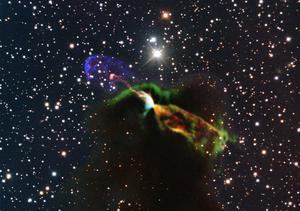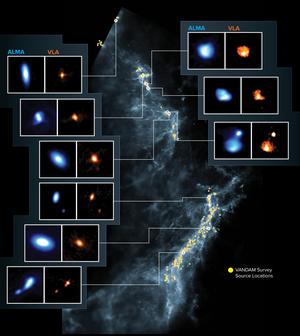Glossary term: Protostar
Description: A protostar is an early stage in the star formation process. It is a large mass of gas and dust formed as a result of the contraction of a giant molecular cloud in the interstellar medium. As the cloud collapses, gravitational energy is converted into heat, warming the still-forming protostar. This phase may take anywhere from 105 to 107 years, depending on the mass of the star, with more massive stars forming more quickly. It begins with an increase in density in the molecular cloud core and ends with the formation of a pre-main-sequence star. Pre-main-sequence stars of similar mass to the Sun are known as T-Tauri stars. Once hydrogen fusion ignites in the core of a star it begins producing energy and becomes a main sequence star.
Related Terms:
See this term in other languages
Term and definition status: This term and its definition have been approved by a research astronomer and a teacher
The OAE Multilingual Glossary is a project of the IAU Office of Astronomy for Education (OAE) in collaboration with the IAU Office of Astronomy Outreach (OAO). The terms and definitions were chosen, written and reviewed by a collective effort from the OAE, the OAE Centers and Nodes, the OAE National Astronomy Education Coordinators (NAECs) and other volunteers. You can find a full list of credits here. All glossary terms and their definitions are released under a Creative Commons CC BY-4.0 license and should be credited to "IAU OAE".
Related Media
Witnessing the birth of a star
Credit: ESO/ALMA (ESO/NAOJ/NRAO)/H. Arce. Acknowledgements: Bo Reipurth credit link
License: CC-BY-3.0 Creative Commons Attribution 3.0 Unported icons
Stellar birth environment
Credit: ALMA (ESO/NAOJ/NRAO), J. Tobin; NRAO/AUI/NSF, S. Dagnello; Herschel/ESA credit link
License: CC-BY-3.0 Creative Commons Attribution 3.0 Unported icons










